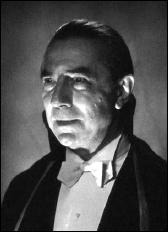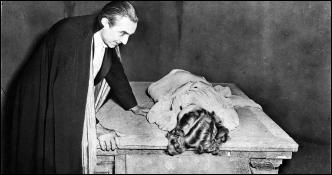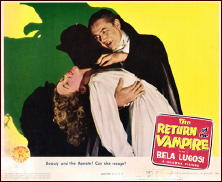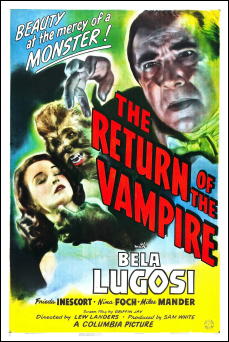Sun 11 May 2014
A Movie Review by Jonathan Lewis: THE RETURN OF THE VAMPIRE (1943).
Posted by Steve under Horror movies , Reviews[12] Comments
THE RETURN OF THE VAMPIRE. Columbia Pictures, 1943. Bela Lugosi, Frieda Inescort, Nina Foch, Miles Mander, Roland Varno, Matt Willis. Director Lew Landers.
The Return of the Vampire is a 1943 Columbia Pictures horror film directed by Lew Landers (The Raven) and starring Bela Lugosi (Dracula). Viewers with even a cursory knowledge of twentieth-century European history will especially appreciate the significance of the film’s historical context, while Lugosi fans will certainly enjoy the Hungarian-born actor’s portrayal of the vampire Armand Tesla, Count Dracula in all but name.
The film, which runs just under 70 minutes, benefits from good pacing, well-developed and believable characters, and the theme of free will in the face of cosmic evil. The latter is something that audiences at the time would likely have implicitly associated with the ongoing campaign against Nazism.
The plot is fairly straightforward, making the film not particularly difficult to follow. We begin in October 1918, a month shy of the end of the Great War. The vampire Tesla and his werewolf assistant, Andreas, inhabit a misty graveyard outside London. Tesla attacks and bites the neck of a young girl named Nikki, who lives in an estate not far from the vampire’s earthly domain.
Nikki’s grandfather, Professor Walter Saunders (Gilbert Emery), and Lady Jane Ainsley (Frieda Inescort), a scientist, soon realize that Nikki’s wound has a dark, supernatural origin. They’re determined to do something about it. Together, they enter the graveyard, find Tesla’s tomb, and drive a stake through the vampire’s heart. This entire sequence is best be interpreted as an allegory of the conclusion to the violent and culturally disruptive First World War.
Unfortunately, peace with Tesla, much like Britain’s peace with Germany, was not built to last. The film shifts forward in time to the Second World War. Lady Jane’s son, John, is engaged to Nikki (Nina Foch) and Andreas (Matt Willis), no longer a werewolf, is working in her laboratory.
But Britain is at war and the Luftwaffe’s bombing raids are taking their toll on London. One such aerial raid directly hits the cemetery and ends up freeing the monstrous Tesla from his coffin. Apparently, the stake through the heart didn’t take.
Tesla transforms Andreas back into a werewolf. He seeks revenge against Lady Jane and sets out to transform Nikki into a vampire. Lady Jane is once again tasked with the unenviable job of battling Tesla who, for a time, passes himself off as Hugo Bruckner, German scientist eager to defect to the United Kingdom. She has the cooperation, if not the full assistance of Scotland Yard investigator, Sir Frederick Fleet (Miles Mander), who simply doesn’t believe in vampires.
Although the film is nominally about Tesla, the character of Andreas plays a prominent role as well. One can interpret his story as either an allegory of the perils of addiction or as previously alluded to, of free will in the face of evil.
The viewer first encounters Andreas as a werewolf, lumbering through a spooky graveyard, completely beholden to his master, Tesla. Andreas’s first on-screen transformation occurs when Professor Saunders drives a stake through Tesla’s heart, freeing him from the vampire’s control and transforming him back into his natural, human form.
Later, Tesla transforms Andreas back into a werewolf. Finally, at the end of the film, Andreas plays the hero and is transformed back into a man. Each transformation represents a turning point in the film’s narrative structure.
In conclusion, The Return of the Vampire is as much a horror film as an allegory about Britain’s two conflicts with Germany. Although the film isn’t a classic, the acting is decent and there is a worthwhile message involved. Most importantly, however, is the fact that it’s actually quite fun, the type of movie one can enjoy on the couch, late at night, lights off and popcorn in hand.





May 12th, 2014 at 1:12 am
It’s probably one of Lugosi’s best roles of the period. Quite interesting that, unlike a lot of the Universal horrors, it does embrace the wartime setting. Unusual, as well, in that the chief vampire hunter is a woman. Frieda Inescort is very good in the role, and it’s a casting decision that’s quite ahead of its time. The whole film can be read any number of ways, but then the Vampire has always been one of the most adaptable myths.
May 12th, 2014 at 3:16 am
This film has garnered some attention around here, probably because it’s so stylishly done.
May 12th, 2014 at 3:43 am
Yes, the film can certainly be read in quite a few different ways.
The theme of belief versus non-belief in the supernatural plays a prominent role as well. I didn’t want to give away spoilers, but the last line in the film makes this clear.
May 12th, 2014 at 3:03 pm
This was a pleasing surprise the first time I saw it, and remains so. The vampire against a contemporary setting is actually a theme of the original Dracula, and the war plays a dual role, both as setting and as an obvious theme, a warning not only of the foreign invader, but the enemy within.
Over all a much better film than anyone had reason to expect.
May 13th, 2014 at 12:20 am
Good point about the enemy within. For a good 35-40 minutes of the film, Tesla is disguised as a German scientist who is allegedly wants to defect. He’s an Eastern European/foreign stranger, an enemy hiding in plain sight in wartime Britain.
The more I think about it, the more I appreciate the opening 5 minutes in the graveyard
May 13th, 2014 at 9:50 am
I’ve fixed up the images so that all of them come from this movie, not from some other one. If I’m still in error, let me know!
May 13th, 2014 at 5:24 pm
Have only seen a few films by Lew Landers, out of his vast output.
But have been keeping notes:
http://mikegrost.com/landers.htm
He’s sometimes a very interesting director.
May 14th, 2014 at 12:06 am
This is a great list, Mike.
I plan to write a bit more about Lew Landers in the months ahead
May 14th, 2014 at 11:49 am
Jonathan:
Couldn’t you find someone more interesting than Landers — and I know he is the new religious symbol — but it is unwarranted, by any careful, or even careless examination of his product.
May 18th, 2014 at 10:00 pm
Anyone with 173 directorial credits on IMDb, both movies and TV, can’t be all bad. Can he?
May 18th, 2014 at 11:58 pm
Steve,
Not at all bad but far from deserving serious critical re-evaluation. Landers began at Universal, moved on to RKO and came to his final film home at Columbia. The budgets, productions schedules and material did not either increase or improve. At the tail end of his RKO period somewhat more ‘important’ projects came his way, Condemned Women, Pacific Liner, seem a little stronger in hindsight, but he appears to have been satisfied by doing an honest job in a timely manner. Nothing at all wrong with Landers, who clearly did not aspire to more. My criticism is with the auteurists who have run short of ‘heroes’ and are searching for inspiration and significance where none exists other than the work itself, designed to complete a double bill with good actors, under contract, either on the way up or down. Some of these films are quite enjoyable as curiosities others are not. See for yourself.
May 20th, 2014 at 6:09 pm
“…but he [Landers] appears to have been satisfied by doing an honest job in a timely manner.”
Agreed. From their titles, all of his films look at least as though they could be entertaining, with a few maybe gems, but no more than that.
I meant to leave an IMDb link in Comment #10, but I see I forgot. So everybody reading this knows what we’re talking about, here goes a complete list:
Terrified (1963)
… aka “Terrified!” – USA (poster title)
“Bat Masterson” (4 episodes, 1959-1961)
– Dead Man’s Claim (1961) TV episode
– The Price of Paradise (1961) TV episode
– A Time to Die (1960) TV episode
– Dead Men Don’t Pay Debts (1959) TV episode
“Sugarfoot” (3 episodes, 1960-1961)
– Stranger in Town (1961) TV episode
– Shepherd with a Gun (1961) TV episode
– The Long Dry (1960) TV episode
“The Case of the Dangerous Robin” (1 episode, 1961)
– The Dead Ringer (1961) TV episode
“Maverick” (2 episodes, 1959-1960)
– Arizona Black Maria (1960) TV episode
– Easy Mark (1959) TV episode
“The Alaskans” (1 episode, 1960)
– White Vengeance (1960) TV episode
“Colt .45” (3 episodes, 1960)
– Alibi (1960) TV episode
– Chain of Command (1960) TV episode
– Phantom Trail (1960) TV episode
“Cheyenne” (1 episode, 1960)
– Riot at Arroyo Seco (1960) TV episode
“Tombstone Territory” (2 episodes, 1959-1960)
– State’s Witness (1960) TV episode
– Grave Near Tombstone (1959) TV episode
“The Adventures of Rin Tin Tin” (22 episodes, 1956-1959)
– Apache Stampede (1959) TV episode
– The Accusation (1959) TV episode
– Stagecoach to Phoenix (1959) TV episode
– Star of India (1959) TV episode
– Grandpappy’s Love Affair (1958) TV episode
(17 more)
“Highway Patrol” (10 episodes, 1955-1959)
– Mexican Chase (1959) TV episode
– Cargo Hijack (1959) TV episode
– False Confession (1958) TV episode
– Train Copter (1958) TV episode
– Stolen Car Ring (1956) TV episode
(5 more)
“Rescue 8” (1 episode, 1959)
– Flash Flood (1959) TV episode
“Mackenzie’s Raiders” (9 episodes, 1958-1959)
– Blood on the Rio (1959) TV episode
– Captured in Mexico (1959) TV episode
– Drought (1959) TV episode
– Long Ride Home (1959) TV episode
– Son of the Hawk (1959) TV episode
(4 more)
Hot Rod Gang (1958)
“Harbor Command” (14 episodes, 1957-1958)
– Lover’s Lane Bandits (1958) TV episode
– Ghost Ship (1958) TV episode
– Smallpox (1958) TV episode
– Arson (1958) TV episode
– Sunken Gold (1958) TV episode
(9 more)
“Casey Jones” (4 episodes, 1957-1958)
– Mrs. Casey Jones (1958) TV episode
– The Gunslinger (1957) TV episode
– Death Rides the Tender (1957) TV episode
– Spurline to Danger (1957) TV episode
“Adventures of Superman” (2 episodes, 1957-1958)
– Superman’s Wife (1958) TV episode
– Three in One (1957) TV episode
“Tales of the Texas Rangers” (18 episodes, 1955-1957)
– Double Reward (1957) TV episode
– A Texas Million (1957) TV episode
– Both Barrels Blazing (1957) TV episode
– Panhandle (1957) TV episode
– Bandits of El Dorado (1956) TV episode
(13 more)
“Circus Boy” (4 episodes, 1957)
– Little Vagabond (1957) TV episode
– Death Defying Dozetti (1957) TV episode
– Counterfeit Clown (1957) TV episode
– Big Top Angel (1957) TV episode
“Whirlybirds” (1 episode, 1957)
… aka “Copter Patrol” – USA (syndication title)
– The Big U (1957) TV episode
“Dr. Christian” (2 episodes, 1957)
– Rabies (1957) TV episode
– Truck Driver (1957) TV episode
The Cruel Tower (1956)
“Tales of the 77th Bengal Lancers” (1956) TV series (unknown episodes)
“Passport to Danger” (1 episode, 1956)
– Baja, California (1956) TV episode
“I Led 3 Lives” (7 episodes, 1953-1956)
– Hit and Run (1956) TV episode
– Convicts (1954) TV episode
– Counterfeit (1954) TV episode
– Infiltration (1954) TV episode
– Baited Trap (1953) TV episode
(2 more)
“Science Fiction Theatre” (1 episode, 1955)
– The Stones Began to Move (1955) TV episode
“Topper” (12 episodes, 1954-1955)
– Topper’s Other Job (1955) TV episode
– Topper’s Insurance Scandal (1955) TV episode
– The Blood Brother (1955) TV episode
– Topper Fights a Duel (1955) TV episode
– Topper’s Accident (1954) TV episode
(7 more)
“Mr. & Mrs. North” (10 episodes, 1952-1954)
– Climax (1954) TV episode
– Mask of Hate (1954) TV episode
– The Girl in Cell 13 (1954) TV episode
– The Placid Affair (1954) TV episode
– Murder for Sale (1954) TV episode
(5 more)
Captain Kidd and the Slave Girl (1954)
“The Cisco Kid” (6 episodes, 1953-1954)
– Cisco Plays the Ghost (1954) TV episode
– The Iron Mask (1954) TV episode
– Outlaw’s Gallery (1953) TV episode
– Indian Uprising (1953) TV episode
– Battle of Red Rock Pass (1953) TV episode
(1 more)
“Your Favorite Story” (3 episodes, 1953-1954)
– The Heroism of Doctor Hallidonhill (1954) TV episode
– High Seas (1953) TV episode
– Colonel Esteban’s Jewel (1953) TV episode
“Meet Corliss Archer” (1 episode, 1954)
… aka “Here’s Corliss Archer” – USA (video title)
– Harry Tells Dex How It Is (1954) TV episode
Captain John Smith and Pocahontas (1953)
“Your Jeweler’s Showcase” (1 episode, 1953)
– Cell 14 (1953) TV episode
Run for the Hills (1953)
“The Files of Jeffrey Jones” (11 episodes, 1952-1953)
– The Lady Wouldn’t Talk (1953) TV episode
– Bullets for the Burlesque Beauty (1952) TV episode
– Killer Bait (1952) TV episode
– Message from a Corpse (1952) TV episode
– Mister Doom (1952) TV episode
(6 more)
Man in the Dark (1953)
… aka “The Man Who Lived Twice” – USA (alternative title)
“The Ford Television Theatre” (1 episode, 1953)
… aka “All-Star Theatre” – USA (rerun title)
… aka “Ford Theatre” – USA (short title)
– Double Exposure (1953) TV episode
Tangier Incident (1953)
“The Adventures of Kit Carson” (21 episodes, 1951-1953)
– Bad Men of Marysville (1953) TV episode
– Ventura Feud (1953) TV episode
– Thunder Over Inyo (1952) TV episode
– The Range Master (1952) TV episode
– Road to Destiny (1952) TV episode
(16 more)
“Terry and the Pirates” (12 episodes, 1953)
– Compound C-3 Theft (1953) TV episode
– Extra Cargo (1953) TV episode
– The Green God (1953) TV episode
– The Randall Affair (1953) TV episode
– Black Market for Death (????) TV episode
(7 more)
Torpedo Alley (1952)
… aka “Down Periscope” – USA (alternative title)
Arctic Flight (1952)
“Schlitz Playhouse” (1 episode, 1952)
… aka “Schlitz Playhouse of Stars” – USA (original title)
… aka “Herald Playhouse” – USA (syndication title)
… aka “The Playhouse” – USA (syndication title)
– Dress in the Window (1952) TV episode
California Conquest (1952)
Jungle Jim in the Forbidden Land (1952)
Aladdin and His Lamp (1952)
“Public Prosecutor” (11 episodes, 1947-1951)
– The Case of the Dead Man’s Voice (1951) TV episode
– The Case of the Devil’s Heart (1951) TV episode
– The Case of Crepe for Suzette (1948) TV episode
– The Case of the Comic Strip Murder (1948) TV episode
– The Case of the Man Who Wasn’t There (1947) TV episode
(6 more)
The Magic Carpet (1951)
Jungle Manhunt (1951)
Hurricane Island (1951)
The Big Gusher (1951)
When the Redskins Rode (1951)
A Yank in Korea (1951)
Blue Blood (1951)
The Bogus Green (1951) (TV)
Revenue Agent (1950)
Last of the Buccaneers (1950)
Chain Gang (1950)
State Penitentiary (1950)
Beauty on Parade (1950)
Dynamite Pass (1950)
Tyrant of the Sea (1950)
Girls’ School (1950)
Davy Crockett, Indian Scout (1950)
Barbary Pirate (1949)
Air Hostess (1949)
Stagecoach Kid (1949)
I Found a Dog (1949)
Law of the Barbary Coast (1949)
Inner Sanctum (1948)
My Dog Rusty (1948)
Adventures of Gallant Bess (1948)
Devil Ship (1947)
My Pal (1947)
The Son of Rusty (1947)
Under the Tonto Rim (1947)
Thunder Mountain (1947)
Danger Street (1947)
Seven Keys to Baldpate (1947)
Doctor Jim (1947)
Death Valley (1946)
Hot Cargo (1946)
The Truth About Murder (1946)
The Mask of Diijon (1946)
Tokyo Rose (1946)
A Close Call for Boston Blackie (1946)
Follow That Woman (1945)
The Enchanted Forest (1945)
The Windjammer (1945)
Shadow of Terror (1945)
Arson Squad (1945)
Secrets of a Sorority Girl (1945) (uncredited)
Trouble Chasers (1945)
The Power of the Whistler (1945)
Crime, Inc. (1945)
I’m from Arkansas (1944)
Black Arrow (1944)
Swing in the Saddle (1944)
U-Boat Prisoner (1944)
Stars on Parade (1944)
The Black Parachute (1944)
Two-Man Submarine (1944)
The Ghost That Walks Alone (1944)
Cowboy Canteen (1944)
The Return of the Vampire (1944)
The Deerslayer (1943)
Doughboys in Ireland (1943)
Redhead from Manhattan (1943)
Murder in Times Square (1943)
After Midnight with Boston Blackie (1943)
Power of the Press (1943)
Junior Army (1942)
Stand By All Networks (1942)
The Boogie Man Will Get You (1942)
Smith of Minnesota (1942)
Sabotage Squad (1942)
Atlantic Convoy (1942)
Submarine Raider (1942)
Not a Ladies’ Man (1942)
Alias Boston Blackie (1942)
Canal Zone (1942)
The Man Who Returned to Life (1942)
Cadets on Parade (1942)
Harvard, Here I Come! (1941)
The Stork Pays Off (1941)
Mystery Ship (1941)
I Was a Prisoner on Devil’s Island (1941)
The Singing Hill (1941)
Back in the Saddle (1941)
Ridin’ on a Rainbow (1941)
Lucky Devils (1941)
Slightly Tempted (1940)
Girl from Havana (1940)
Sing, Dance, Plenty Hot (1940)
… aka “Mania for Melody” – USA (reissue title)
Wagons Westward (1940)
La Conga Nights (1940)
Ski Patrol (1940)
Enemy Agent (1940)
Honeymoon Deferred (1940)
Bad Lands (1939)
Conspiracy (1939)
The Girl and the Gambler (1939)
Fixer Dugan (1939)
Twelve Crowded Hours (1939)
Pacific Liner (1939)
Annabel Takes a Tour (1938)
The Affairs of Annabel (1938) (uncredited)
Smashing the Rackets (1938)
Sky Giant (1938)
Blind Alibi (1938)
Law of the Underworld (1938)
Condemned Women (1938)
Double Danger (1938)
Crashing Hollywood (1938)
Danger Patrol (1937)
Living on Love (1937)
Flight from Glory (1937)
Border Cafe (1937)
You Can’t Buy Luck (1937)
The Man Who Found Himself (1937)
They Wanted to Marry (1937)
Night Waitress (1936)
Without Orders (1936)
Parole! (1936) (as Louis Friedlander)
The Adventures of Frank Merriwell (1936) (uncredited)
Stormy (1935) (as Louis Friedlander)
… aka “Heart of a Stallion” – USA (reissue title)
The Raven (1935) (as Louis Friedlander)
The Call of the Savage (1935) (as Louis Friedlander)
… aka “Savage Fury (II)” – USA (recut version)
The Rustlers of Red Dog (1935) (as Louis Friedlander)
Tailspin Tommy (1934) (as Louis Friedlander)
The Red Rider (1934) (as Louis Friedlander)
The Vanishing Shadow (1934) (as Louis Friedlander)